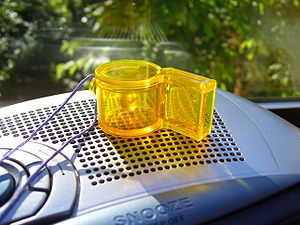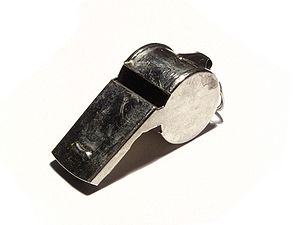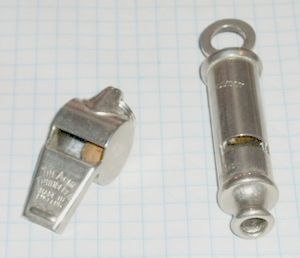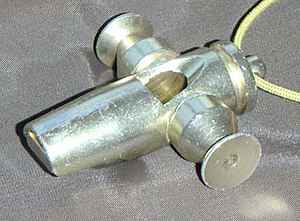Difference between revisions of "AY Honors/Whistles/Answer Key"
(←Replaced content with '<object width="425" height="344"><param name="movie" value="http://www.youtube.com/v/Zq5FeHzKtqw&hl=en&fs=1"></param><param name="allowFullScreen" value="true">...') |
(→History: Egypt remark needs citation) |
||
| (2 intermediate revisions by the same user not shown) | |||
| Line 1: | Line 1: | ||
| − | + | {{otheruses}} | |
| + | |||
| + | [[Image:Party whistle on radio.jpg|thumb|right|A party whistle.]] | ||
| + | [[Image:Pea Whistle.jpg|thumb|A metal pea whistle.]] | ||
| + | |||
| + | A '''whistle''' is a simple [[woodwind]] [[musical instrument|instrument]] which produces [[sound]] from a stream of forced air. | ||
| + | |||
| + | Many types exist, from small [[police]] and [[sports]] whistles (also called [[pea whistle]]s), to much larger [[train whistle]]s, which are [[steam whistle]]s specifically designed for use on [[locomotive]]s and [[ship]]s. Although whistles have a musical characteristic (for example train whistles sound a [[Minor seventh chord|minor-seventh musical chord]]) whistles are not usually considered "musical" in the sense of being able to play a chosen melody, but mainly the small whistles can also be used as a – very shrill and loud – [[noise instrument|noise]] and [[rhythm instrument]]. However, musical whistles exist, including any of several 2-[[octave]] musical instruments known as [[tin whistle]]s (sometimes known as pennywhistles or low whistles), as well as the [[calliope (music)|calliope]] (an array of separately actuable steam whistles), [[Organ (music)|organ]] pipes and the [[recorder]]. Pea whistles are used in [[jazz]] and [[Latin music]] as a [[percussion instrument]], and children often use them as a toy music instrument. | ||
| + | |||
| + | The whistle works by causing the smooth flow of air to be split by a narrow blade, sometimes called a [[fipple]], creating a [[turbulence|turbulent]] [[vortex]] which causes the air to vibrate. By attaching a [[Acoustic resonance|resonant]] chamber to the basic whistle, it may be tuned to a particular note and made louder. The length of the chamber typically defines the resonance [[frequency]]. A whistle may also contain a small light ball, usually called the ''[[pea]]'', which rattles around inside, creating a [[chaos|chaotic]] [[vibrato]] effect that intensifies the sound. [[Japanese people|Japanese]] [[bird whistle]]s use several small balls and are half filled with water in order to reproduce the sound of a [[bird song]]. | ||
| + | |||
| + | A steam whistle works the same way, but using steam as a source of pressure: such whistles can produce extremely high sound intensities. | ||
| + | |||
| + | Sometimes, unintentional whistles can be set up. A common one is the opened [[sunroof]] of a [[Automobile|car]]: air passing over the top of the vehicle can, at certain speeds, strike the back edge of the sunroof, creating a very low frequency whistle which is resonated by the closed interior of the car. Since the sound frequency is [[infrasonic]], around 4 [[Hertz|Hz]], the effect is very uncomfortable for occupants, who feel the vibration rather than hear it. Such low frequencies can induce [[nausea]], [[headache]], [[delirium|disorientation]] and [[dizziness]]. The effect can be prevented by opening a side window a few inches. Subsonic whistles have also been developed for use as weapons, or to deliberately create a sense of uneasiness in an enemy.{{Fact|date=September 2007}} | ||
| + | |||
| + | ==History== | ||
| + | The whistle has its roots dating back to ancient China. Chinese night watchmen used to blow into the tops of acorns in order to alert the towns of invading Mongolians.{{Fact|date=March 2008}} | ||
| + | |||
| + | In ancient Egypt two blades of the papyrus plant along the Nile river were held together in between the palms. By blowing into the palms the papyrus leaves would make a loud vibrant sound.{{Fact|date=January 2009}} | ||
| + | |||
| + | In 1868 [[Joseph Hudson (inventor)|Joseph Hudson]] of [[Birmingham]], England, made the first whistle ever to be used by a [[football referee]]. [[New Zealand]] referee William Atack was the world's first to use a whistle to stop a game of sport in 1884. It was used for the first time (allegedly) at a game held at Nottingham Forest, prior to this referees used handkerchiefs to attract players' attention. | ||
| + | |||
| + | By 1884, Joseph Hudson had perfected his whistles and he released the world's most successful whistle to date, the "Acme Thunderer" (the first ever pea whistle). The whistle has been used as an alarm or attention-getting instrument by all manner of industries, sports and revellers. It continues to sell in great quantities throughout the world. | ||
| + | |||
| + | ==Police whistles== | ||
| + | |||
| + | [[Image:Police whistles.jpg|thumb|Examples of police whistles]] | ||
| + | |||
| + | Since the [[Metropolitan Police Service]]s inception in 1829, [[Police officer|officers]] have been issued with the "Metropolitan" whistle. Prior to this, police used hand rattles,<ref>Taylor, J. [http://www.constabulary.com/mystery/rattle.htm "The Victorian Police Rattle Mystery"] ''The Constabulary (2003)</ref> with whistles only being used as musical instruments or toys. Both rattles and whistles were used to call for back-up in areas where neighbourhood beats overlapped, and following their success in [[London]], the whistle was adopted by most counties in England. | ||
| + | |||
| + | [[J Stevens & Son]] made police whistles from around the 1840s and Thomas Yates' Beaufort whistles equipped the [[Liverpool Police]] in the 1870s. The 1880s and 1890s saw police whistles made by [[W Dowler & Sons]], [[J Hudson & Co]], [[J Barrall]], [[R A Walton. A De Courcy & Co]] manufactured the same about 1900. | ||
| + | |||
| + | [[Police]] whistles fell largely into disuse in some countries in 1969, when early hand-held radios were brought into service. With the rise of the motor car, the whistle was no longer usefully audible in urban areas. The whistle is still used by some police forces today, and engraved ceremonial versions are sometimes presented to police officers upon occasions such as their retirement. | ||
| + | |||
| + | ==Industrial whistles== | ||
| + | |||
| + | Industrial whistles are used for [[Distress signal|signal]]ling and [[time]]keeping both on [[railroad]] and [[ship]]s, and in [[factory|factories]]. Most of these whistles were [[steam power]]ed and not standardized. Individual [[locomotive]]s could be identified by their whistles. At noontime in industrial areas up into the 1950s whistles of every pitch could be heard, as each factory had a boiler and a whistle, if not full steam power. | ||
| + | |||
| + | Railroads in particular used elaborate whistle codes for communication both within the [[train]] and with other trains. These methods are maintained today with motor-powered [[air horn]]s. Trucks also use air horns, especially since they often have air brakes and so there is already a source of compressed air on board. | ||
| + | |||
| + | [[Train whistle]]s generally produce three or four different frequencies at the same time, to produce a non-[[major chord]], that is distinct, loud, and low in pitch. | ||
| + | |||
| + | Ship's whistles must be very loud for [[International Regulations for Preventing Collisions at Sea#Part D - Sound and light signals|safety on the seas]]. Modern ship's whistles can be electrically driven or [[Steam whistle|steam]] driven. {{RMS|Queen Mary}} was originally equipped with three electric ''Tyfon'' whistles in 1932. They could be heard at least ten miles away and were tuned to 55 Hz, a low bass ''A'' note that was chosen for maximum passenger comfort despite the high sound pressure level.<ref>[http://www.sterling.rmplc.co.uk/visions/funnel2.jpg The Voice of the Queen Mary]</ref> One of the three whistles was taken back to Kockum Sonics in [[Malmö]], [[Sweden]], where it was refurbished for a new life of service aboard the [[RMS Queen Mary 2|RMS ''Queen Mary 2'']]. Modern [[International Maritime Organization|IMO]] regulations specify ships' whistle frequencies to be in the range 70-200 Hz for vessels that are over 200 meters in length.<ref>[http://www.kockumsonics.com/products/marine/marine_tyfon_imo_regulations.htm Kockum Sonics: Tyfon product IMO regulations]</ref> Traditionally, the lower the frequency, the larger the ship. The ''Queen Mary 2'', being 345 meters long, was given the lowest possible frequency (70 Hz) for her regulation whistles which means she carries both 70 Hz modern whistles and a single vintage 55 Hz whistle. | ||
| + | |||
| + | ==Safety== | ||
| + | Whistles are often used as warning devices or as safety devices serving to attract attention to the user. Some [[cyclist]]s use a whistle as a substitute for a [[bell (instrument)| bell]] or [[Horn (acoustic)|horn]]. It should be noted, however, that many jurisdictions require that the warning device be permanently attached to the [[bicycle]]. | ||
| + | |||
| + | Rescue or survival whistles are often packed in [[survival kit]]s and attached to [[personal flotation device]]s to allow a victim to signal for help. The whistle is audible at much greater distances than the human voice, and is less likely to cause exhaustion if used repeatedly. Survival whistles differ from pea whistles in that they are usually flat, so that water cannot collect inside if the user is immersed, for example after falling overboard from a boat. | ||
| + | |||
| + | Whistles can also produce sounds at pitches inaudible to the human ear such as dog whistles which can be heard by dogs at a range beyond that of human sensory perception, or at least conscious perception. | ||
| + | |||
| + | ==Sporting== | ||
| + | Whistles are used by referees to officiate sporting matches. Some sports use different types of whistles, but one used around the world in many sports is the [[Fox 40]], a pealess whistle which creates sound using air pressure only. | ||
| + | |||
| + | The Fox 40 is used in Basketball, Hockey, Ice Hockey, Soccer and numerous other games, as it can be heard easily over the noise of the audience. | ||
| + | |||
| + | Another whistle widely used for sports such as Touch Football, Rugby League and Rugby Union is the Thunderer 58.5 by [[Acme Whistles]]. It is a metal whistle containing a cork pea. It is used mainly because of its design that allows the user to create a deep, low-pitch shrill that can be heard from hundreds of meters away. | ||
| + | |||
| + | ==Music== | ||
| + | [[Image:SambaWhistle.jpg|thumb|A samba whisle with three tones]] | ||
| + | The whistle is used in [[batucada|samba percussion groups]] as a leader help to catch the percussionnist attention. The traditional samba whistle has three tones, but as the number of musicians rises in the percussion section, pealess whistles became more popular due to their high pitch and their loud sound. | ||
| + | |||
| + | ==References== | ||
| + | {{reflist}} | ||
| + | |||
| + | ==External links== | ||
| + | *[http://jquarter.members.beeb.net/walk15a.htm Joseph Hudson & Co history]dead link 29 october 2008 | ||
| + | *http://blog.whistlemuseum.com/ Whistle Museum | ||
| + | |||
| + | [[Category:Flutes]] | ||
| + | [[Category:Whistles]] | ||
| + | [[Category:Hiking equipment]] | ||
| + | |||
| + | [[de:Trillerpfeife]] | ||
| + | [[es:Silbato]] | ||
| + | [[eo:Fajfilo]] | ||
| + | [[fr:Sifflet]] | ||
| + | [[gl:Chifre]] | ||
| + | [[id:Peluit]] | ||
| + | [[it:Fischietto]] | ||
| + | [[nl:Scheidsrechtersfluitje]] | ||
| + | [[ja:ホイッスル]] | ||
| + | [[pl:Gwizdek]] | ||
| + | [[pt:Apito]] | ||
| + | [[ru:Свисток]] | ||
| + | [[scn:Friscalettu]] | ||
| + | [[simple:Whistle]] | ||
| + | [[sr:Звиждаљка]] | ||
| + | [[fi:Pilli]] | ||
| + | [[sv:Visselpipa]] | ||
| + | [[tl:Silbato]] | ||
| + | [[vec:Fiŝċiòt]] | ||
Revision as of 01:54, 28 January 2009
A whistle is a simple woodwind instrument which produces sound from a stream of forced air.
Many types exist, from small police and sports whistles (also called pea whistles), to much larger train whistles, which are steam whistles specifically designed for use on locomotives and ships. Although whistles have a musical characteristic (for example train whistles sound a minor-seventh musical chord) whistles are not usually considered "musical" in the sense of being able to play a chosen melody, but mainly the small whistles can also be used as a – very shrill and loud – noise and rhythm instrument. However, musical whistles exist, including any of several 2-octave musical instruments known as tin whistles (sometimes known as pennywhistles or low whistles), as well as the calliope (an array of separately actuable steam whistles), organ pipes and the recorder. Pea whistles are used in jazz and Latin music as a percussion instrument, and children often use them as a toy music instrument.
The whistle works by causing the smooth flow of air to be split by a narrow blade, sometimes called a fipple, creating a turbulent vortex which causes the air to vibrate. By attaching a resonant chamber to the basic whistle, it may be tuned to a particular note and made louder. The length of the chamber typically defines the resonance frequency. A whistle may also contain a small light ball, usually called the pea, which rattles around inside, creating a chaotic vibrato effect that intensifies the sound. Japanese bird whistles use several small balls and are half filled with water in order to reproduce the sound of a bird song.
A steam whistle works the same way, but using steam as a source of pressure: such whistles can produce extremely high sound intensities.
Sometimes, unintentional whistles can be set up. A common one is the opened sunroof of a car: air passing over the top of the vehicle can, at certain speeds, strike the back edge of the sunroof, creating a very low frequency whistle which is resonated by the closed interior of the car. Since the sound frequency is infrasonic, around 4 Hz, the effect is very uncomfortable for occupants, who feel the vibration rather than hear it. Such low frequencies can induce nausea, headache, disorientation and dizziness. The effect can be prevented by opening a side window a few inches. Subsonic whistles have also been developed for use as weapons, or to deliberately create a sense of uneasiness in an enemy.Template:Fact
History
The whistle has its roots dating back to ancient China. Chinese night watchmen used to blow into the tops of acorns in order to alert the towns of invading Mongolians.Template:Fact
In ancient Egypt two blades of the papyrus plant along the Nile river were held together in between the palms. By blowing into the palms the papyrus leaves would make a loud vibrant sound.Template:Fact
In 1868 Joseph Hudson of Birmingham, England, made the first whistle ever to be used by a football referee. New Zealand referee William Atack was the world's first to use a whistle to stop a game of sport in 1884. It was used for the first time (allegedly) at a game held at Nottingham Forest, prior to this referees used handkerchiefs to attract players' attention.
By 1884, Joseph Hudson had perfected his whistles and he released the world's most successful whistle to date, the "Acme Thunderer" (the first ever pea whistle). The whistle has been used as an alarm or attention-getting instrument by all manner of industries, sports and revellers. It continues to sell in great quantities throughout the world.
Police whistles
Since the Metropolitan Police Services inception in 1829, officers have been issued with the "Metropolitan" whistle. Prior to this, police used hand rattles,& with whistles only being used as musical instruments or toys. Both rattles and whistles were used to call for back-up in areas where neighbourhood beats overlapped, and following their success in London, the whistle was adopted by most counties in England.
J Stevens & Son made police whistles from around the 1840s and Thomas Yates' Beaufort whistles equipped the Liverpool Police in the 1870s. The 1880s and 1890s saw police whistles made by W Dowler & Sons, J Hudson & Co, J Barrall, R A Walton. A De Courcy & Co manufactured the same about 1900.
Police whistles fell largely into disuse in some countries in 1969, when early hand-held radios were brought into service. With the rise of the motor car, the whistle was no longer usefully audible in urban areas. The whistle is still used by some police forces today, and engraved ceremonial versions are sometimes presented to police officers upon occasions such as their retirement.
Industrial whistles
Industrial whistles are used for signalling and timekeeping both on railroad and ships, and in factories. Most of these whistles were steam powered and not standardized. Individual locomotives could be identified by their whistles. At noontime in industrial areas up into the 1950s whistles of every pitch could be heard, as each factory had a boiler and a whistle, if not full steam power.
Railroads in particular used elaborate whistle codes for communication both within the train and with other trains. These methods are maintained today with motor-powered air horns. Trucks also use air horns, especially since they often have air brakes and so there is already a source of compressed air on board.
Train whistles generally produce three or four different frequencies at the same time, to produce a non-major chord, that is distinct, loud, and low in pitch.
Ship's whistles must be very loud for safety on the seas. Modern ship's whistles can be electrically driven or steam driven. Template:RMS was originally equipped with three electric Tyfon whistles in 1932. They could be heard at least ten miles away and were tuned to 55 Hz, a low bass A note that was chosen for maximum passenger comfort despite the high sound pressure level.& One of the three whistles was taken back to Kockum Sonics in Malmö, Sweden, where it was refurbished for a new life of service aboard the RMS Queen Mary 2. Modern IMO regulations specify ships' whistle frequencies to be in the range 70-200 Hz for vessels that are over 200 meters in length.& Traditionally, the lower the frequency, the larger the ship. The Queen Mary 2, being 345 meters long, was given the lowest possible frequency (70 Hz) for her regulation whistles which means she carries both 70 Hz modern whistles and a single vintage 55 Hz whistle.
Safety
Whistles are often used as warning devices or as safety devices serving to attract attention to the user. Some cyclists use a whistle as a substitute for a bell or horn. It should be noted, however, that many jurisdictions require that the warning device be permanently attached to the bicycle.
Rescue or survival whistles are often packed in survival kits and attached to personal flotation devices to allow a victim to signal for help. The whistle is audible at much greater distances than the human voice, and is less likely to cause exhaustion if used repeatedly. Survival whistles differ from pea whistles in that they are usually flat, so that water cannot collect inside if the user is immersed, for example after falling overboard from a boat.
Whistles can also produce sounds at pitches inaudible to the human ear such as dog whistles which can be heard by dogs at a range beyond that of human sensory perception, or at least conscious perception.
Sporting
Whistles are used by referees to officiate sporting matches. Some sports use different types of whistles, but one used around the world in many sports is the Fox 40, a pealess whistle which creates sound using air pressure only.
The Fox 40 is used in Basketball, Hockey, Ice Hockey, Soccer and numerous other games, as it can be heard easily over the noise of the audience.
Another whistle widely used for sports such as Touch Football, Rugby League and Rugby Union is the Thunderer 58.5 by Acme Whistles. It is a metal whistle containing a cork pea. It is used mainly because of its design that allows the user to create a deep, low-pitch shrill that can be heard from hundreds of meters away.
Music
The whistle is used in samba percussion groups as a leader help to catch the percussionnist attention. The traditional samba whistle has three tones, but as the number of musicians rises in the percussion section, pealess whistles became more popular due to their high pitch and their loud sound.
References
- ↑ Taylor, J. "The Victorian Police Rattle Mystery" The Constabulary (2003)
- ↑ The Voice of the Queen Mary
- ↑ Kockum Sonics: Tyfon product IMO regulations
External links
- Joseph Hudson & Co historydead link 29 october 2008
- http://blog.whistlemuseum.com/ Whistle Museum
de:Trillerpfeife es:Silbato eo:Fajfilo fr:Sifflet gl:Chifre id:Peluit it:Fischietto nl:Scheidsrechtersfluitje ja:ホイッスル pl:Gwizdek pt:Apito ru:Свисток scn:Friscalettu simple:Whistle sr:Звиждаљка fi:Pilli sv:Visselpipa tl:Silbato vec:Fiŝċiòt




